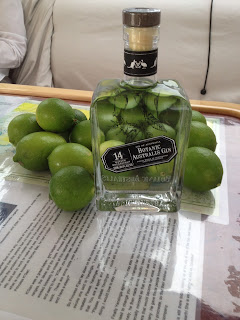The weather didn't look too bad the next morning, hiding as we were in a protected bay. Seriously though, looking out to sea from our anchorage, the sea state had moderated a great deal, and the lure of an internet signal enticed us into to being on our way.
What did we have to loose, by just poking our nose out around the corner and seeing what it was like? Planned destination for the day, a mere 11nm away, to the shelter of Lloyd Island off Quintell Beach and the possibility of a signal for the internet!
Away we went, conservatively reefed down for what we expected would be stronger wind, once we rounded and passed Restoration Rock.
 |
| Restoration Rock seen to port .Restoration Island is to starboard |
Why Restoration Rock? Time for another William Bligh fact, as we are apparently following in reverse, his route to Kupang , but soon our courses will finally diverge.
Bligh, having been floating around in somewhat less comfort than ourselves, enroute from Tahiti,to somewhere hospitable,happened upon the aptly named Great Barrier Reef. Unlike one of his predecessors, he managed to nail an entrance, using his trusty sextant , chronometer and what chart there was- although how that works without a chart is still a mystery to me , as the trusty chronometer and sextant would only be a record of where he had been- none the less , he made it through, so well done Lieutenant Bligh.
History (and I suppose Bligh's journal) reveal that they landed some 25nm NW from this entrance at what we now know as Restoration Island ,so named for the dual facts that they landed on the day that celebrated the restoration of Charles the second to the throne and secondly as they apparently felt mightly restored,having dined on oysters and fruit and water they found there.
We passed safely between the island and the rock, and didn't stop to dine on either oysters or fruit. Coffee and a kit kat for us instead .
The weather moderated throughout the morning, so we reassessed and decided to make for Night Island, a further 25nm south from Lloyd Island. Allegedly an internet signal was found in this anchorage as well.
We had jagged an updated weather report as we passed through the zone off Restoration Island, so were happy that the weather was in fact easing according to the Met Bureau prognosis as well.
The last time I passed through the Reef in my professional life was, I calculated, 1981. I was certainly aware that many, many more navigation aids-(lights) had been added to the Reef over the years, but was oblivious to the fact that a new route had opened in 2004. The new route which is inside the outer reef edge, is basically a straight line run, which means that no longer does all the traffic have to navigate the 120nm Inner route down through Princess Charlotte Bay,which for us, would culminate with a 25nm leg to the East at the end, to round Cape Melville, which with the prevailing wind would have rated highly on the scale of nightmarish to tedious.
By using LADS Passage -so named after the "
Laser Airborne Depth Sounder flight, which conducted the majority of the hydrographic survey work for identifying the new route" ** we would be able to both save 25nm and take advantage of the wind which was now forecast to back from the ESE to NE- perfect!
So plan change number three and we took advantage of what both mother nature was promising and the splendid work of the Australian hydrogphers.
One long tack of 11.5nm, took us out of Lloyd Bay, to a position we could commence our run south. The wind didn't quite back far enough so another tack was required which took us towards the reef again , just south of Bligh's entrance and then we were away.
Using the magnificent depth information available on the chart, we stayed to the East of the official outer track and had a brilliant run through the night, in the little over a quarter waxing moonlight and a E- NE'ly breeze Oh yes, this is what it's all about!
 |
track out of Lloyd Bay and run down inside the outer edge of the Reef.
NB Old route (still an option) is seen closer to the coast |
 |
| Same same, but different scale |
** information obtained from LADS Passage and Fairway Channel article 01.01.2008











































